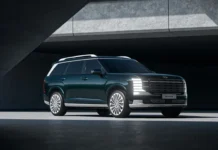President Trump accelerated tariff plans with a new 25% duty on all vehicles and parts manufactured outside the United States.
The word “whipsaw” has been tossed around these past few months as the Trump administration enacts (and sometimes delays, then enacts) tariffs on countries around the globe, ostensibly to address those nations’ trade imbalances with the United States. Now, there’s a new announcement to add to the list as of April 3 at 12:01 AM ET, as the White House confirmed both automobiles and their parts will see 25% tariffs, with one particular carve-out.
As the White House addressed questions on Trump’s latest automotive-focused levies, the White House noted that vehicles imported under the stipulations of the United States-Mexico-Canada Agreement (USMCA), which Trump signed into law in 2020, would get a reprieve, at least while the Department of Commerce develops a process for enacting similar tariffs on Canada and Mexico (per NBC News).
President Trump announced 25% tariffs on cars imported from both the U.S.’ neighboring trade partners earlier this month, before summarily pausing those levies for a 30-day period, 24 hours after they went into effect.
That month-long period is nearly up, and Trump announced Wednesday the latest 25% duty on imported vehicles would go into effect and be “permanent” — suggesting we will not see exceptions or a repeal for the duration of his administration.
The solution, he included with today’s announcement, is simple: “If you build your car in the U.S., there’s no tariff.”
Several major automakers already manufacture vehicles in the United States, though the picture gets far more complex when you consider where their parts are sourced. BMW, for example, builds most of the SUVs it sells in North America at its facility in Spartanburg, South Carolina (including the X3, X4, X5, X6, X7 and XM). Volvo has a manufacturing plant in South Carolina, to say nothing of other major automakers with plants throughout the U.S. including Toyota, which has 13 facilities largely concentrated in the South. Honda, Hyundai, Kia, Mazda (as a joint-venture with Toyota), Mercedes-Benz, Nissan, Subaru and Volkswagen Group all operate assembly plants and have at least part of their supply chain situated within the United States.
That said, those selfsame automakers — as well as the Big Three — also have manufacturing capacity outside the U.S. The Dodge Hornet, based on the same platform as the Alfa Romeo Tonale, is built in Italy. As we covered before, several models are also built in Canada and Mexico (under the terms of NAFTA, then the USMCA).
Earlier reports on tariffs against Canada, China and Mexico noted prices for imported vehicles could increase to the tune of $4,000 to $12,000, depending on the type and MSRP of the vehicle in question.
While markets reacted about how you’d expect to the news (with several automakers closing 3-5% down at the end of Wednesday trading), early signs are that the on-again, off-again nature of these tariffs haven’t hampered the auto industry in a dramatic fashion just yet. However, we are just around the corner from automakers releasing their Q1 2025 sales data, which will provide clearer insight into how recent news has impacted business, and perhaps offer a glimpse into what we might expect from American car buyers over the coming months.

























